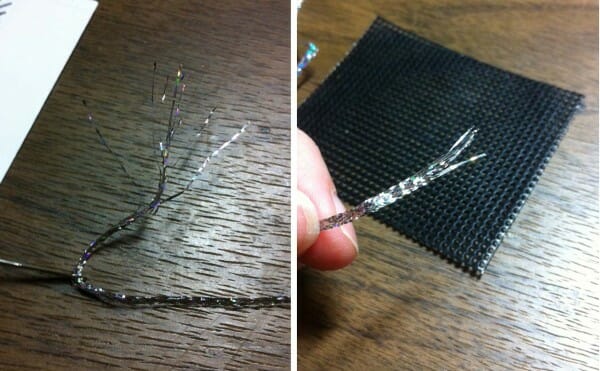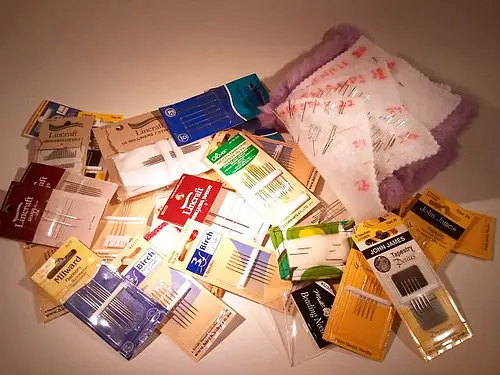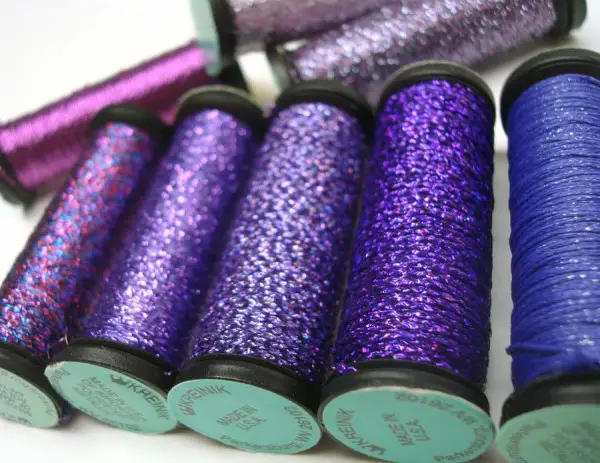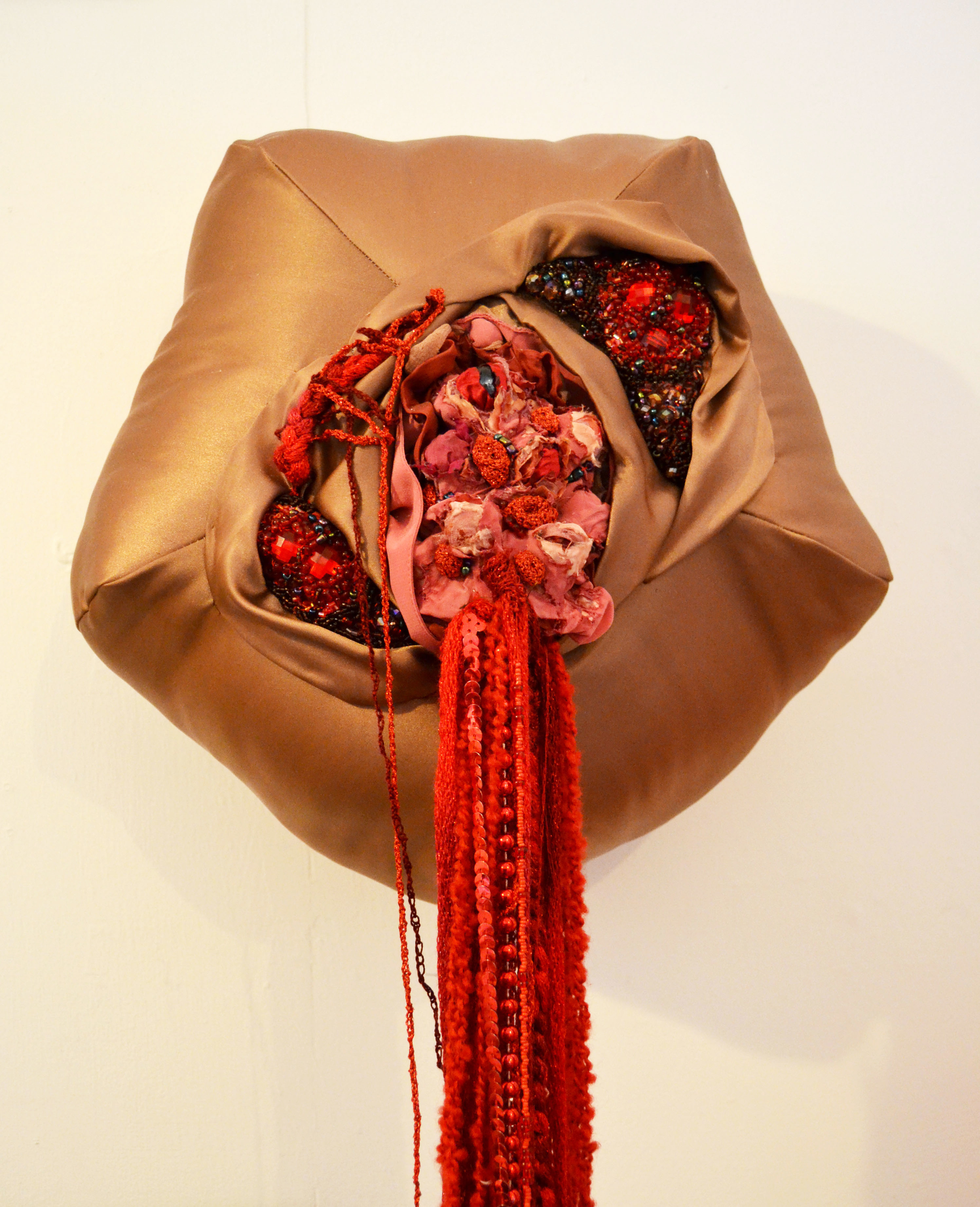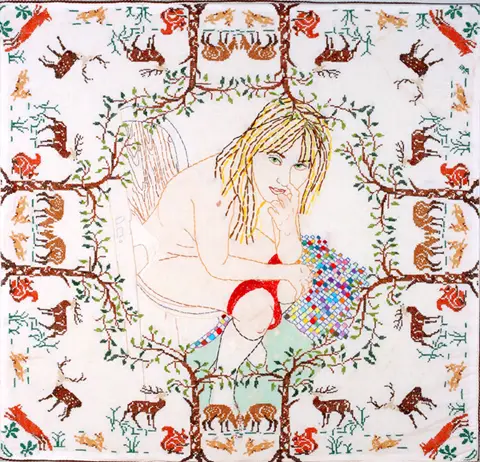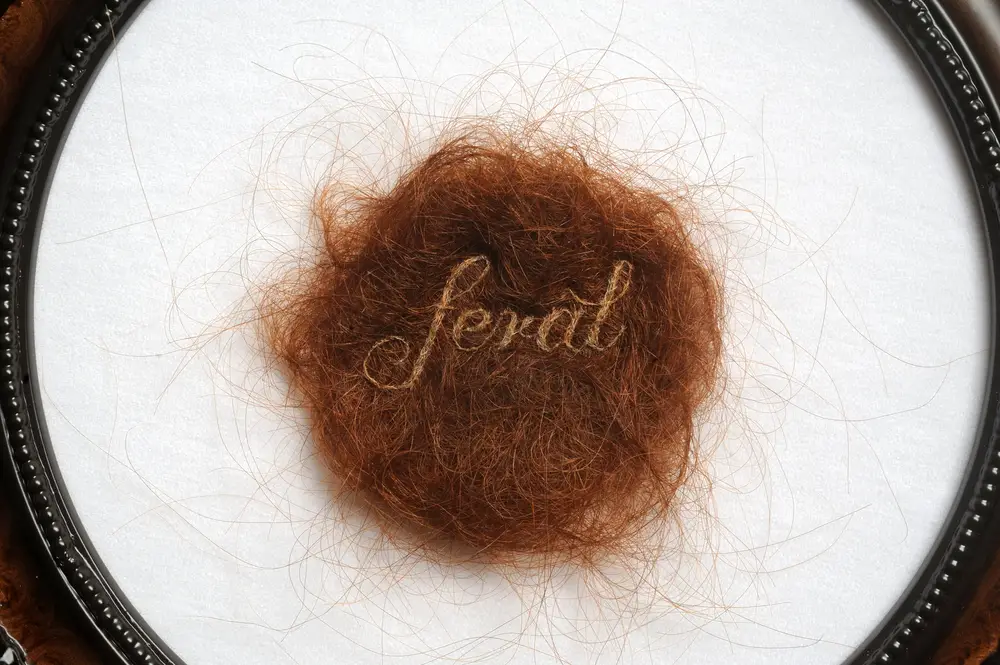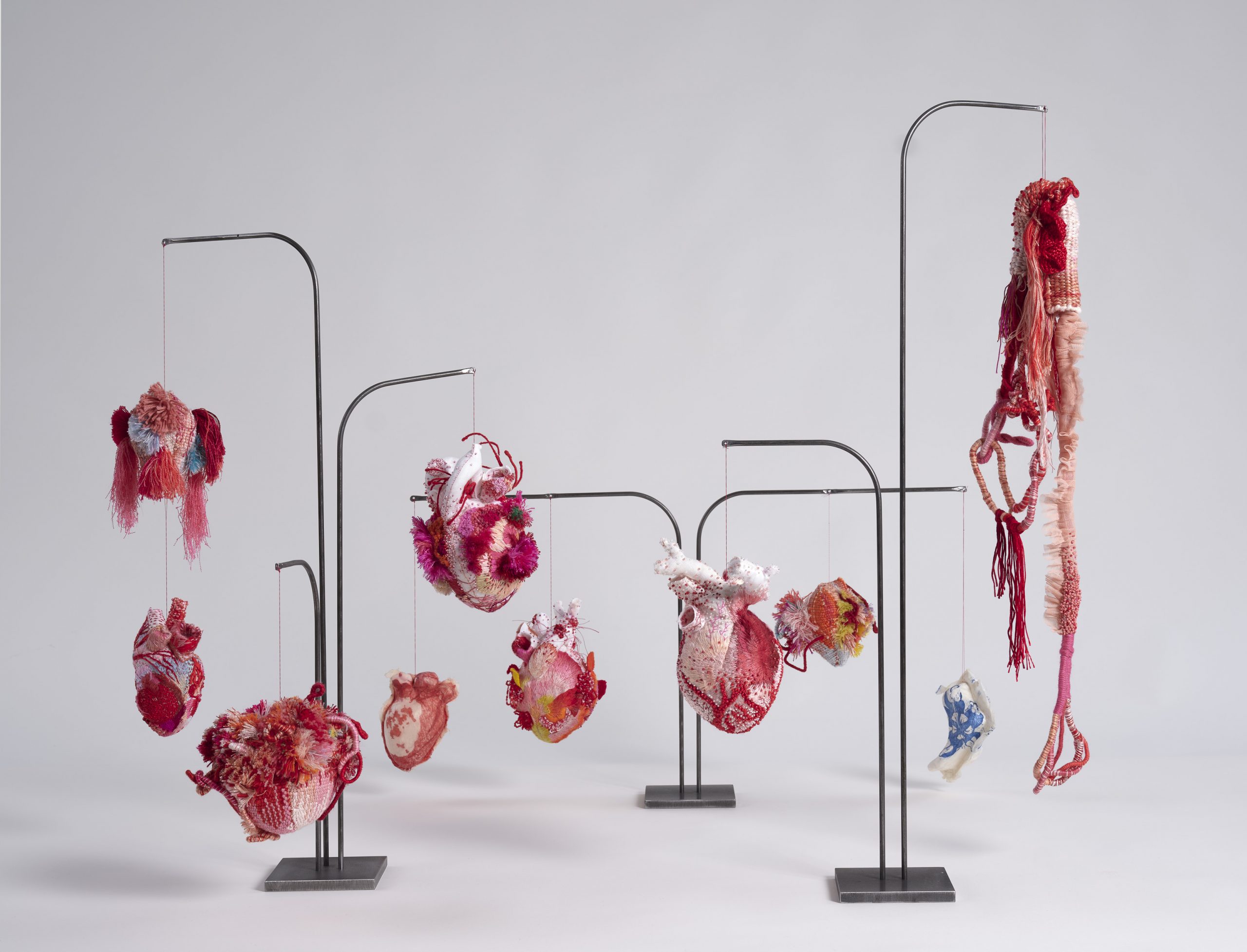
After a 15 year absence from art, it came back into Zsófia Szász‘ life. From helping her grandmother with her embroidery as a child, the feelings burned into the artists core memory and she now feels at home when working with any kind of yarn. We were lucky enough to delve deeper into her journey with an interview in our latest issue of XStitch Magazine – Issue 27: Flora.
Tell us how you came to this point, making these works:
I really like to make connections to things that I haven’t seen being combined before, I often feel as a bridge between two very different parts of life. Not only with art forms, but in general, with things that I haven’t met before.
I was experimenting with some embroidery on my paintings when I got a huge opportunity from Barabasi Lab, a network scientist group in Boston, at the end of 2020 to embroider huge 200 x 200 cm artworks. These works are based on data from research, mapping phone calls from emergency situations (bombs, riots, etc.) In this project the science really met art, especially handmade embroidery.
It was, and still is, a huge confirmation to me that my ambitions are right; there is room for new connections in the contemporary canon. Since then my mind has been wandering freely: I made a QR code with cross stitch embroidery that links to my webpage, and a contemporary poem’s binary code as well. I made thread arts on paper, on nets and now, on leaves.

Illustration has been a companion for a long time–can you see a path back from your early childhood drawings to the work you are making now?
It was a bumpy road. In my childhood, my surroundings were supportive of my art, up to a certain point. My family and my teachers told me I was talented, but no one recommended learning art in high school, because “art will never payoff”. When I was 13 I had to support my best friend during her admission process to the art school I craved for, but that I couldn’t even try.
It broke my young soul. I had to go to a secondary school specialising in accountancy, and I instantly stopped all art forms that I loved and was good at (drawing, ceramics, music) and became a typical rebel teenager. More than 10 years passed this way, until film-making came into my life. I was an Assistant Director for a time, and an Editor for a few years. It was fun, yet I always felt something fundamental was missing.
I was 28 years old when a film series that we worked on for years failed. Doing illustrations was my escape to create something meaningful. I don’t consider it particularly fateful, I just had a lot of free time, without any work. I saw a post on Instagram that I liked and thought: I can do something like this!

I went to my nearest paper store, bought some paper and pen and just started drawing a line art illustration of a cat head that was really decorated and detailed. I didn’t even sketch it, just went with the flow, the more time it takes, the better.
After a 15 year absence from art, it came back to my life. I feel whole since I found embroidery, that roots deep in my personality. My father’s mother, who was a typical pleasant woman in the little village in south Hungary where I spent my childhood, she was the last in my family who was doing this craft. I helped her when I was little, but I was so young, I don’t really remember those times, but the feelings burned into my core memory. I feel home when I work with any kind of yarn.
Want Some More Embroidery Tips?
How did the Love Letters come to you?
In the fall of 2021 I had a small down hill period in my life. I expected a greater response from a big exhibition than what happened, and my family life was all time crazy. I worked night and day, so I was exhausted and felt empty. One day when we were walking the dog near a big city park, my boyfriend-whom I knew that time for less than a half year-asked me out of the blue: “When did you do something just for you at the last time?”
The directness of the question hit me hard, I couldn’t even answer properly, while the thought immediately occupied a central place in my head: but really? When? I spent the following days thinking about what was new in my life? What was a topic that I was deep in enough to speak of? And I just realised it was him! He is the new in my life, my feelings for him, what came to my life when I was deepest in chaos.

So I decided, no matter how unromantic I am, how little connection I felt with this topic before, I’ll speak about love! The leaves were with me for more than a year then, I collected them without any particular purpose. I lived in a flat those times where there was a huge Sycamore tree-and then it just clicked. These very thick, vulnerable but timeless things should be canvases of the works which speak about the most vulnerable feeling in a people’s life and every stitch could mean a little scar that we made on each other while we bonded.
And something new and beautiful was born. But of course, I didn’t have my pink glasses on when I chose the motifs. And I knew, only the luckiest relationships can last forever-but I feel every type of connection deserves to be seen.And speaking of connections, in Hungarian the word “letter” means something you write and also means a leaf from a tree. A perfect combination!
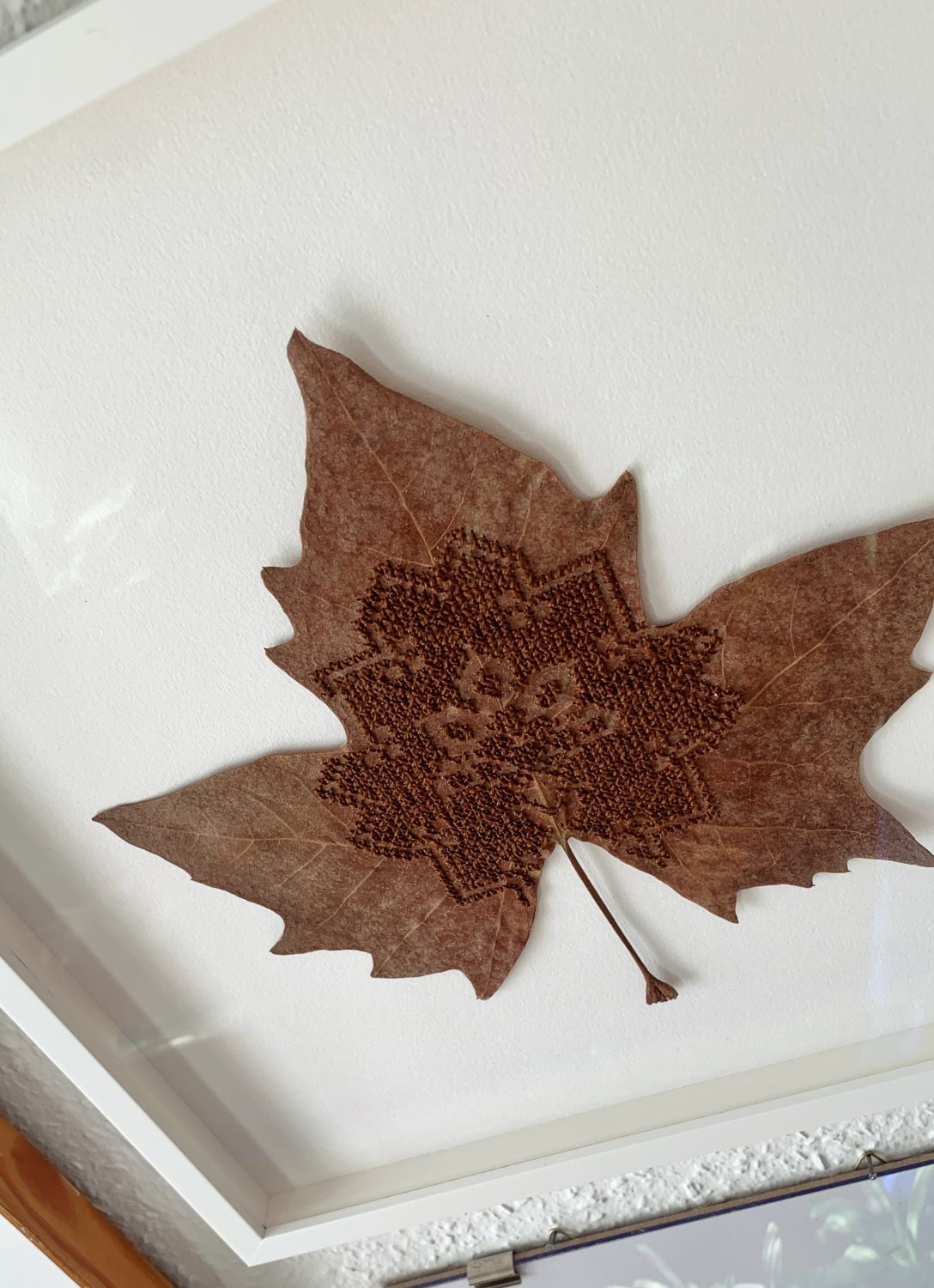
Please explain some of the technical challenges of stitching onto leaves.
The thing everyone sees in these things first is the extreme fragility of the leaves. I don’t use any special preserving process with these, just clean them and press them until they dry perfectly flat. When I’m stitching I have to be careful with the cross eyes, because when I punch a hole, that is permanent. There is no undo or chance for a repair, but I of course, make mistakes. Every leaf has some empty scar, so they are not perfect. But what relationship is?
Does your work reflect the Hungarian traditions of needlework?
All of the motifs are traditional Hungarian or Transylvanian patterns with as little modification as possible. I find it very important to make a living connection between the contemporary era and our heritage. I believe these motifs have to come out of museums and the bubbles of heritage preservation and into our everyday life.
But yet it’s not realistically expectable from the people of today to like and wear these old motifs from hundreds of years ago. If we want to reach more people and younger people we should use methods that we haven’t used before. This craft form should merge into contemporary art, because the museums simply conserve them. I feel these leaves draw fresh attention and curiosity to these motifs, and infuse them with life.

Do you have artistic influences that inspire you?
I can’t name an artist or a style that gave me constant inspiration. I try to live with an open mind, see as many types of artwork as I can and sometimes something just clicks with me. I spend a lot of time online, just browsing other artists’ works in any medium.
I admire artists who can use their cultural heritage in fresh, new ways. I think we have to be more adventurous with these things-with all the respect for our roots of course. And I like works that surprise me somehow in a unique way, it doesn’t matter what the medium is or what culture it grew from.

Reading back through this interview, it is a pleasure to reflect on the inspiration I feel from Zsófias work. The cultural influences from traditional Hungarian Textiles is clear, but what is special is how she intertwines contemporary mediums to ensure these traditional works are accessible to modern audiences. It’s both about preservation and evolution. This, mixed with the vulnerability of the Love Letters bring a very human experience to engaging with her work, that resonates deeply with a very human need for connection, nostalgia, and looking to the future.
If you, like me, love what you see you can follow Zsófia on Instagram and check out her website here.
And finally, if you wan’t to dive into more floral stitch inspiration, you can get our Flora Issue of XStitch here.

